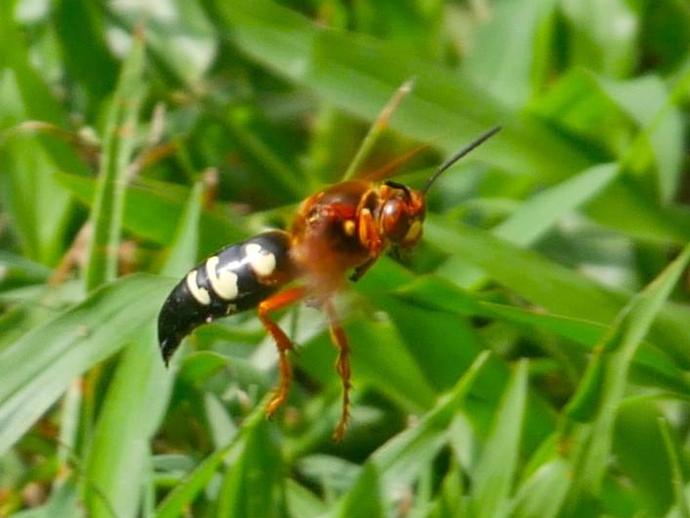July 30, 2020
The eastern cicada killer (Sphecius speciosus) is one of our largest and most impressive wasps -- especially if you happen to catch one doing what it does best.
These solitary digger wasps can measure up to two inches long, with the females slightly larger than the males. The females need every bit of that size because they need the strength that comes with it. The adult wasps emerge in late June/early July and the females can often be spotted hovering over lawns looking for places to dig burrows. Their burrows are quite distinctive as the loose soil they push from the burrow forms a little mound with a trench leading to the entrance.
Once the burrow is dug, the female flies off in search of a cicada (they prey on annual cicadas, by the way, which are the cicadas that emerge every summer). Once she finds one, she stings it, which paralyzes it. Then she has the unenviable task of carrying the cicada all the way back to her burrow. Since the cicada may weigh twice what the wasp does, cicada killers will sometimes drag the cicada up a tree in order to gain enough altitude to make it back to the burrow.
Once the cicada is safely inside a chamber within the burrow, the cicada killer will lay a single egg on the cicada and seal up the chamber. The egg hatches within a day or two and the larva makes short work of the cicada, then overwinters until the following spring, at which point it enters pupation and emerges as an adult in the summer.
Despite their large size and fearsome appearance, cicada killer wasps don't present much of a danger to humans. They only sting if handled roughly or stepped on, and according to those who have been stung, the experience isn't much worse than a pinprick. #BenInNature
ABOUT THIS POST
Social distancing can be difficult, but it presents a great opportunity to become reacquainted with nature. While he is working from home, Administrator of Science Ben Williams is venturing outdoors each day to record a snapshot of the unique sights that can be found in the natural world.
NATURE PHOTO IDENTIFICATIONS
If you discover something in nature that you would like help identifying, be sure to message us right here on Facebook with a picture (please include location and date of picture) and we'll have our experts help you identify it!

 Hours & Admissions
Hours & Admissions Directions
Directions

